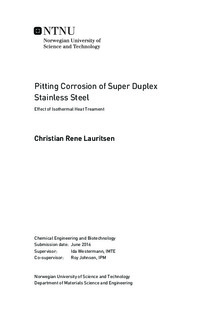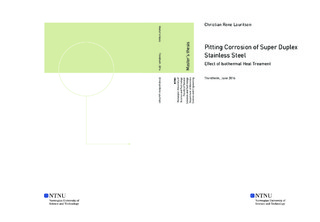| dc.description.abstract | Super duplex stainless steels (SDSS), with a chromium content of 25 wt$\%$, contain a duplex structure which consists of ferrite and austenite, and have a pitting resistance equivalent number (PREN) equal or higher than 40. SDSS are affected by the alloying elements, microstructure and fabrication processes. The high degree of alloying elements in SDSS can lead to formation of intermetallic precipitates and secondary phases during heat treatments. Detrimental phases, such as sigma ($\sigma$) - phase, the $\chi$ - phase, seconday austenite ($\gamma _{2}$) and chromium nitrides can form in the temperature range of 700 - 950$^{\circ}$C. The phases can form during welding or due to improper heat treatments and affects localized corrosion resistance and mechanical properties of SDSS.
The main objective with this work was to investigate the effect of isothermal heat treatments on localized corrosion properties of a high tungsten SDSS, UNS S39274. The isothermal heat treatments were performed at 870$^{\circ}$C, 820$^{\circ}$C and 940$^{\circ}$ to from intermetallic precipitates and secondary phases. The $\sigma$ - phase, the $\chi$ - phase, $\gamma _{2}$ and chromium nitrides were emphasized in this thesis. To investigate the localized corrosion properties of UNS S39274, electrochemical measurements were performed on isothermal heat treated samples. The electrochemical measurements consisted of critical pitting temperature (CPT) measurements and anodic cyclic potentiodynamic polarization measurements. Localized corrosion morphology was investigated by surface characterization with optical light microscope after electrochemical measurements. The objective with this was to determine the effect of isothermal heat treatments on localized corrosion morphology. Another objective was to determine a critical isothermal heat treatment time at a given isothermal heat treatment temperature, where a reduction in localized corrosion resistance of UNS S39274 was observed.
The solution annealing at 1110$^{\circ}$C for 15 minutes lead to no formation of intermetallic precipitates and secondary phases, and was verified by surface characterization in SEM. The average CPT of solution annealed samples was determined to be 77,5$^{\circ}$C. At the isothermal heat treatment temperature 870$^{\circ}$C, 820$^{\circ}$C and 940$^{\circ}$C, the average CPT was reduced by 32,5$^{\circ}$C, 22,5$^{\circ}$C and 15$^{\circ}$C after 4 minutes of isothermal heat treatment.
E$_{p}$ was generally found to decrease with increasing electrolyte test temperature. At an electrolyte test temperature of 80$^{\circ}$, E$_{p}$ was found to decrease with 87,7 mV$_{SCE}$ for samples in solution annealed condition to samples heat treated at 870$^{\circ}$C for 2 minutes. E$_{p}$ was found to be stable of samples tested at an electrolyte temperature of 40$^{\circ}$ and 60$^{\circ}$ for the same heat treatment conditions. At an electrolyte test temperature of 40$^{\circ}$C, E$_{p}$ was found to decrease with 160,6 mV$_{SCE}$ and 72,8 mV$_{SCE}$ from samples in solution annealed condition to samples isothermal heat treated at 820$^{\circ}$C and 940$^{\circ}$ for 4 minutes, respectively. At an electrolyte test temperature of 60$^{\circ}$C, E$_{p}$ was found to decrease with 408,7 mV$_{SCE}$ and 215,0 mV$_{SCE}$ from samples in solution annealed condition to isothermal heat treated samples at 820$^{\circ}$C and 940$^{\circ}$C for 4 minutes, respectively.
An increasing amount of localized corrosion initiation sites was found with increasing isothermal heat treatment times at a given isothermal heat treatment temperature. The localized corrosion was found to initiate at grain boundaries, and to a higher degree with increasing isothermal heat treatment time at a given isothermal heat treatment temperature. | |

